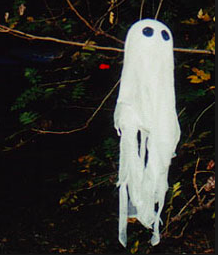Death Takes a Holiday
On my walk through nearby woods yesterday I paused in a stand of trees when something caught my eye. It wasn’t one of the Cedar Waxwings or Dark-eyed Juncos that I’d been watching flit through the greenery. A gauzy grey ghost hung from a mailbox, swinging ominously in the morning breeze. Of course, it’s Halloween.
Although our lives are undeniably impermanent, in our culture we keep reminders of our inevitable death hidden, unless it’s Halloween.
In Mexico at this time of year, The “Dios de los Muertes,” or “Days of the Dead” festival lasts for four days and involves building altars to ancestors, visiting cemeteries, and parading with symbols of death: ghosts, and skeleton dolls. All are indications of how death is viewed as a natural part of the life cycle. Halloween is similar to Dios de las Muertes, but lasts only one day, and is more like a carnival—dressing up as anything we want. Skeletons and ghosts are part of cast of characters, but not the sole focus.
Since Bringing Bubbe Home came out, I’ve been talking a lot about the “world of death.” When I cared for my grandmother in the last months of her life, our whole family was pulled into a different world. It’s similar to the first months with a new baby when there’s so much attention and adjusting to the infant that you barely get sleep, and hardly get out. With a new baby, though, people love to visit and coo over the new being. They’re not as eager to visit a dying person, which makes the world of death all the more isolating. I was surprised by some friends who didn’t show up for the entire five months Bubbe was with us. It was as if we had something scary and contagious in our basement.
That was eighteen years ago, and I think our culture’s acknowledgement of death has evolved. As baby boomers age we’re beginning to face our impending death the same way we’ve looked at everything–with an attempt to be conscious and awake. We’re noticing that embracing death can snap the transitory nature of life into sharp focus, offering fertile ground for growth. When death is in our face, other matters fade, so we can zero in on completing our life, whether by loving, forgiving, or simply appreciating this temporary realm.
A famous Rabbi, known as the Chofetz Hayim, was once visited by a traveler. The guest was surprised to see that the Rabbi’s house was very bare.
“Rebbe,” he asked, “Where is your furniture?”
The Rebbe replied, “And, where is Your furniture?
The traveler said, “Mine? I’m just passing through.’
“Ah”, said the Rebbe, “Me, too.”
We’re all just passing through, whether we try to deny it or not. Sometimes when I see a leering Jack-o-lantern or a wispy swaying ghost, I shudder, as if I see my death grinning at me from around the corner. If we confronted those reminders of our temporary status more often, perhaps we could not only handle our own deaths more gracefully, but we’d live our lives with more presence and gusto.



Leave a Reply
Want to join the discussion?Feel free to contribute!